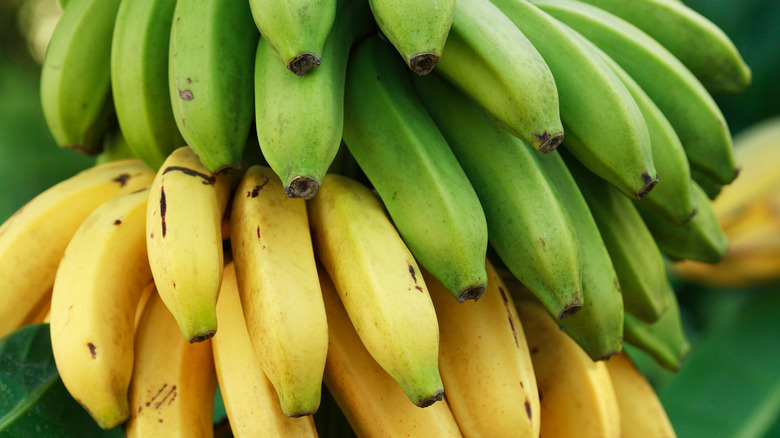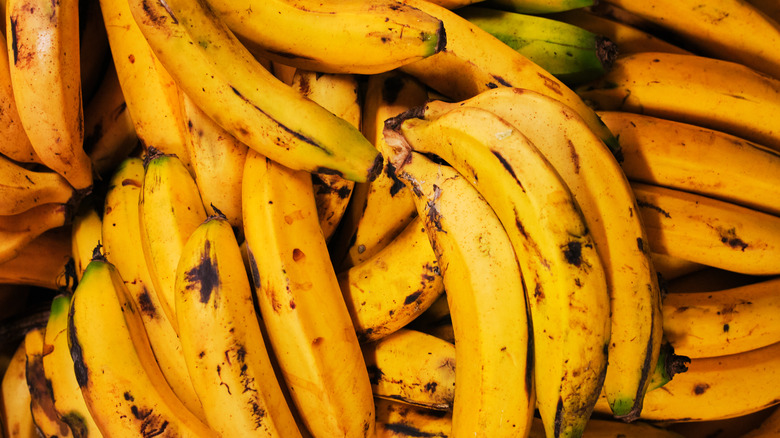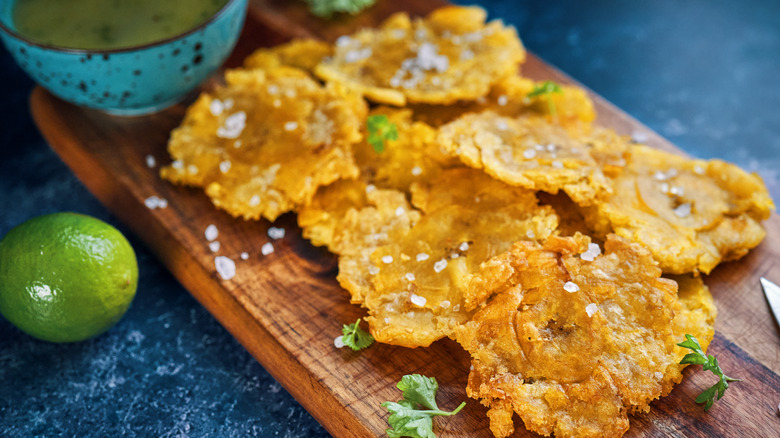The Easy Way To Tell When A Plantain Is Ripe
Plantains have been part of our diets for thousands of years, and were brought to the Americas through the trans-Atlantic slave trade, where they became a staple food in Latin America – especially in countries like Colombia, Ecuador, Costa Rica, and the Dominican Republic.
They're typically mistaken for bananas, but if you've ever bitten into one with banana flavors in mind, you'll quickly find they're not the same thing at all. Plantains are larger, have tougher skin, and are not meant to be eaten raw. When they're cooked, they take on a delightful starchy, savory sweetness that makes them a favorite ingredient in many Latin American dishes, from tostones to mofongo to plátano maduro con queso.
But how do you know when a plantain is ripe? Unfortunately, it's not always that obvious since you'll see green plantains on menus and in snacks all over Latin America, leading many to wonder if these tropical fruits are actually served unripe (they are).
You'll know when plantains have ripened when they look yellow and are softer to the touch. Ripe plantains typically have more brownish-black spots peppering the peel, too. At this point, they're sweeter and perfect for making all sorts of delicious dishes. Whether you prefer them ripe or unripe, it's easy to become a pro at picking the right plantains to use for various dishes, from chips to stews to desserts.
Ripe plantains are yellow and soft
Ripe plantains are soft, delicate, and bursting with flavor (when cooked; ripe plantains aren't typically consumed raw). Unlike their green and unripe counterparts, ripe plantains have a pleasant sweetness that makes them perfect for desserts and snacks alike.
Walking through the grocery store or the farmers' market, it's easy to miss the subtle signs that tell you when plantains are ripe and ready to elevate your culinary game. As mentioned, ripe plantains are yellow. But we don't mean "kind of yellow." We mean bright, vibrant, golden yellow. Ripe plantains should also be somewhat soft to the touch. When you gently press on the skin, it should yield easily, as if it's giving you a little plantain hug. You don't want it to be too mushy or squishy, but it also shouldn't be hard.
Why do plantains change color as they ripen? It's all thanks to the process of ethylene gas production. As plantains ripen, the enzymes in the fruit turn the starches into sugars. This process is accelerated by the release of ethylene gas, which causes the fruit to soften and change color. So, if you want to ripen green plantains quickly, you can place them in a paper bag to trap that ethylene gas.
How to cook with ripe and unripe plantains
One of the most popular foods made with ripe plantains are tajadas, which are sweet fried plantains often served as a side dish. They're super easy to make, too. Simply slice the ripe plantains thinly (about ½ inch thick) and skillet-fry them with oil until golden brown. Serve them hot, and watch as they disappear from the plate in seconds.
For a more substantial meal, try mofongo, which you can actually make with either ripe or unripe plantains depending on your flavor preferences. It's a traditional Puerto Rican and Dominican dish consisting of mashed plantains mixed with garlic and pork cracklings, then topped with shrimp, chicken, or vegetables.
If you can't wait for the plantains to ripen, green plantains are perfect for making tostones, or crispy fried plantain slices. To make them, slice the unripe plantains into discs and then fry them twice: once to soften them so they can be smashed and again to make them crispy. Those with more skills in the kitchen can try their hand at more intricate plantain-based dishes, such as alcapurrias, aborrajados, or plantain dumplings from Peru, known as tacacho.
See how versatile plantains are? Don't be intimidated the next time you're at the grocery store and spot these relatives of bananas. With a little know-how, you can cook delicious plantain-based dishes regardless of whether they're ripe or not.


